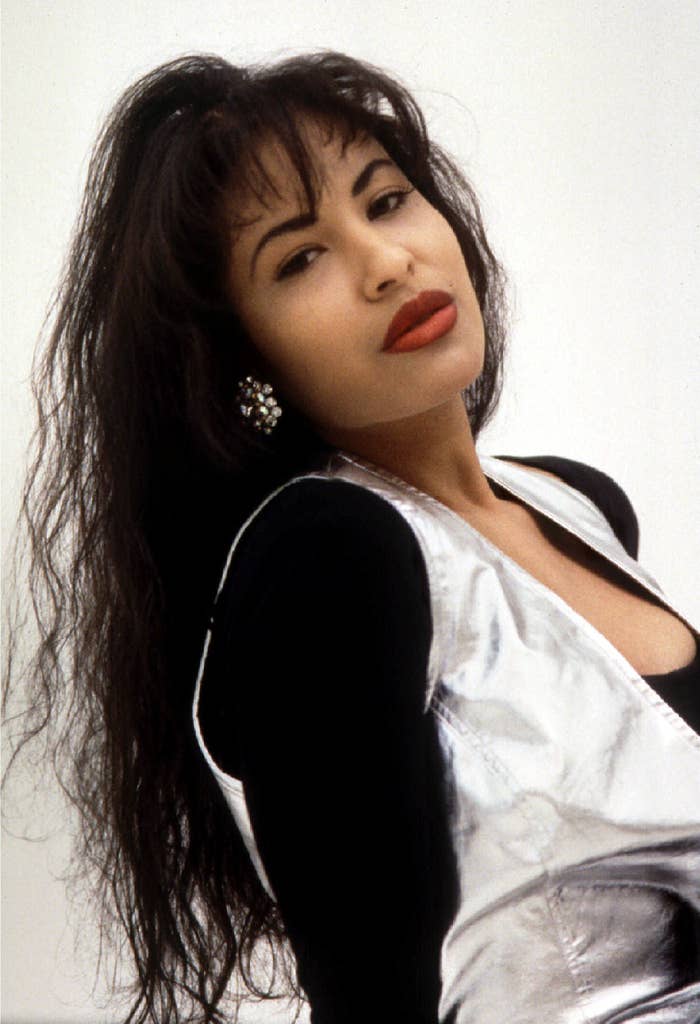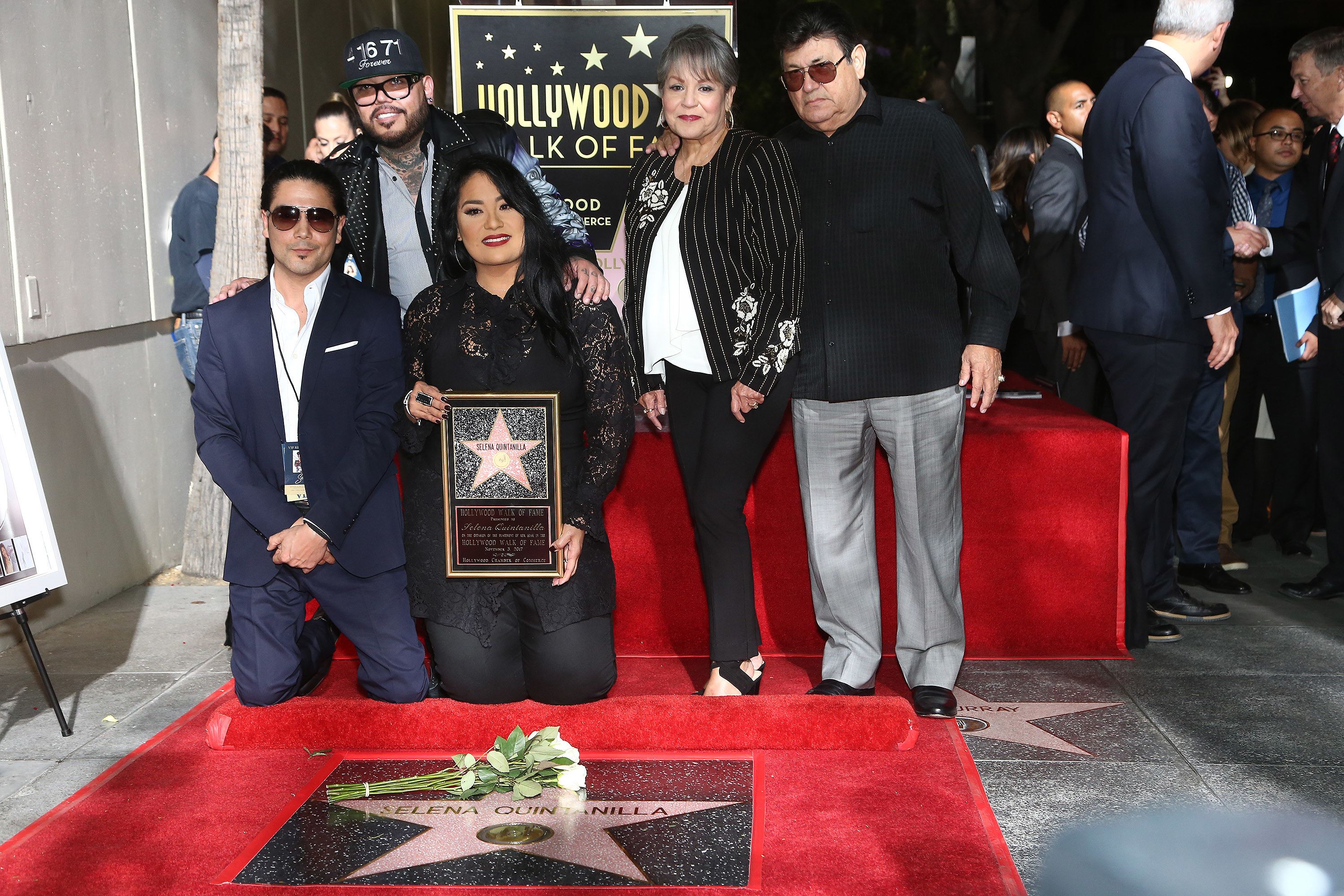
This year marks a quarter century since Selena’s tragic murder when she was just 23. The singer’s electrifying performance style and sparkly bustiers transformed her from Tejano queen into a Grammy-winning Latinx pop supernova by the early ‘90s.
By 1995, she was on the verge of conquering mainstream pop charts when her fan club president, Yolanda Saldívar, killed her. But since her untimely death, the Selena legend has only grown: Her legacy lives on in Univision specials, a museum, academic studies, a makeup line, among next-gen pop stars, and perhaps most memorably in the iconic 1997 film Selena starring Jennifer Lopez.
That film, like so much of her career, was produced by her father, Abraham Quintanilla (through his Q-Productions). It focused not just — or even mostly — on Selena, but on the Quintanilla family’s backstory and journey, which makes sense because the Selena phenomenon wasn’t just about her. Her accompanying band, Los Dinos, was created by her dad and included her drummer sister, Suzette, and producer brother, A.B.
When Netflix announced its two-part miniseries Selena: The Series, also produced by Q-Productions last year, I was skeptical that it would add much to what we already know about the singer. And pictures of newcomer Christian Serratos looked exactly like Lopez’s Selena, suggesting the miniseries would simply franchise the family-friendly movie into a TV format. (The first nine episodes of the miniseries are out today. The second part’s release date hasn’t yet been announced.)
The new series mostly does stick to that script, at least in the first half. The singer remains the sweet girl who loved her family, defied her dad in order to marry her bandmate, Chris Pérez, and lived for fashion. Still, there’s a shamelessly corny charm to the miniseries, which further fleshes out some of the family’s story. And, unlike most music biopics that focus on the melodrama of a star’s life, the show is at its best illuminating the band’s musical trajectory. Ultimately, though, the show adds little to the narrative fans of Selena already know.

Like the movie, the series traces the beginning of the Selena phenomenon directly to her father’s own frustrated ambition. Abraham Quintanilla struggled as a young man to make it with his band Los Dinos, experiencing racism as a Mexican American band playing to white audiences. He gave up on his own musical dreams once his children arrived and instead channeled his artistic ambition into a family band.
The new Dinos featured his youngest daughter, Selena, as vocalist, backed by her siblings, A.B. on guitar and bass and a reluctant Suzette at the drums. They became a kind of Latinx Jackson family in their Corpus Christi, Texas, home, practicing endlessly in the garage and singing at their family restaurant.
The show frames Quintanilla’s gruff style and “stage dad” antics as a benevolent, loving dictatorship. As they expand into weddings and start touring in festival circuits, he takes Selena out of school when her teacher wants her to spend more time on her classwork. Tellingly, Selena isn’t even in the scene where he tells the teacher she’s not coming back.
He pushes all the children to excel in their musical areas, including A.B.’s songwriting, Suzette’s percussion, and Selena’s Spanish. She struggles to learn to sing in Spanish and adapt to the Tejano genre that was popular among their growing audiences. Selena is charmingly clueless as she tries to sell funky Jody Watley songs with English lyrics to Spanish-speaking, older couples. She turns to soap operas to up her skills enough to handle interviews as the band begins being featured on television.
Fans of Selena’s entire body of work — and not just the later crossover songs — will love seeing her perform early Tejano songs, like “Ven Conmigo” and “Yo Fui Aquella.” The show makes viewers root for the band through re-creations of their appearances on The Johnny Canales Show and her wins at the Tejano Music Awards.
When the media talks about “crossover” — a term that has fallen out of favor — they mostly refer to a Spanish-language performer singing in English and getting Anglo magazine covers. But the show focuses on another crossover Selena had to enact, from the regional Tejano genre into “Latin” pop.
A.B. finally gets credit for being instrumental in combining genres — in particular bringing in cumbia and rock elements to Latin pop — and helping the band to bridge audiences. (After Selena’s death, A.B. later created his own successful band.) The show savvily depicts the clueless white stylists and photographers of major label EMI trying to sell her as an exotic “world” artist (in a Moroccan-inspired hairstyle) as she makes the jump from Tejano to Latin pop charts.
The show savvily depicts the clueless white stylists and photographers of major label EMI trying to sell her as an exotic “world” artist.
But it was Selena’s stage pizzaz, sensuality, fashion, and versatility that made the band so special. She could belt out schmaltzy ballads, convey ranchera heartbreak, sell new jack swing pop, all with her own performance style. She could effortlessly shift from aerobically pop choreographies to commanding a stage with dramatic hand gestures. In these musical interludes, star Christian Serratos re-creates the singer’s charm and dance moves as ably as Lopez.
The show’s nuance around the band’s musical trajectory doesn’t carry into its depictions of the family’s personal lives, however. As the siblings find themselves offstage, it attempts to create dramatic tension around A.B. and his devotion to his wife and newborn while on the road. A similar conflict animates the depiction of Suzette and her partner. But it gets a little repetitive with the siblings all struggling with balancing their work commitments with their family and personal lives.
The depictions of the women in particular — especially Suzette — aren’t as fleshed out as the men. As A.B. has to prove himself again and again as the band’s musical producer, in some ways, even Selena’s perspective gets lost in the shuffle. Arguably that depiction might simply be true to life, since Selena was only one part of the band and they were all under the dad’s direction. (“Talk to my dad,” she says to a music executive who approaches her for their major label deal.)
In one scene where A.B. gets upset with Selena because she’s focused on her fashion ideas instead of giving him her all in the production booth, we’re meant to sympathize with him over Selena. The label will always make another Selena album, he explains, but he has to prove himself as a producer. But in centering these conflicts around A.B., we lose sight of how much Selena’s fashion contributed to the band’s success.
When she falls for long-haired rocker bandmate Chris Pérez, she turns to her brother for help, asking A.B. to find out if Pérez likes her, prompting a comment that she sounds like a high schooler. She has to remind him that she didn’t go to high school. The scene shows just how sheltered she was, but such moments focused distinctively on her perspective are few and far between.

The first part of the series ends before the drama surrounding Selena’s relationship with her eventual husband, Pérez, gets resolved and before she wins her first Grammy. Presumably, the next season will focus on those moments and on her eventual murder. (There are scenes of Yolanda Saldívar, the nurse and Selena uber-fan who murders her, entering the family orbit.)
But because Selena died so young — before she had really come into her own as a woman — it’s hard to imagine that the series will add more insight into our understanding of her. Like many other artists who died too soon — Kurt Cobain or Aaliyah, to name two — Selena’s untimely death meant mourning not only the massive talent that we got to experience but also all the promise of what might have come after.
Beyoncé was almost 30 when she fired her father as her manager and started really pushing the boundaries of her image. I’ll always wonder what Selena would have done with her music and her interest in fashion, or if an English-speaking career would have meant as much to her as it meant to her dad. (And I can’t help but wonder how A.B. and Selena would have made reggaeton their own.)
It’s hard to believe Selena would have been 49 this year. In some ways, her image will forever be trapped as an angelic daddy’s girl. In his 2012 memoir, her husband made headlines simply for writing about the fact that the couple considered divorcing. Selena’s dad subsequently sued him when he tried to turn the memoir into a TV series.
Quintanilla has a history of opposing Selena projects not explicitly sanctioned by him. He also attacked the 2018 series, Selena’s Secret, based on a 1997 book by a Univision journalist. The book included allegations that before her death, Selena had fallen in love with her plastic surgeon, Dr. Ricardo Martínez. Quintanilla called the series a tabloid cartoon, but Martínez finally confirmed in 2012 that they had an affair.
Those revelations hint at a woman attempting to find herself outside the boundaries of her family and only add to Selena’s complexity. But there is no trace of that persona in the angelic girl of Selena: The Series. Instead, the show’s Selena lives on as something of a one-dimensional myth. ●
